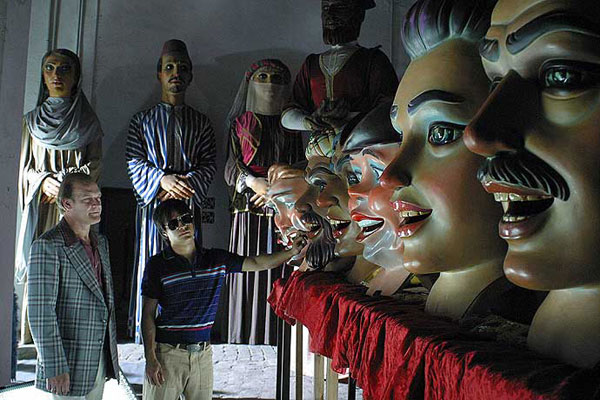Movie review by Greg Carlson
While director Pedro Almodovar chooses immediately to musically invoke Hitchcock’s “Psycho” during his opening credit sequence (a Saul Bass-esque cut-and-paste doozy of reds, blacks, and whites), the movie that ends up being re-imagined more thoroughly throughout the great Spanish director’s “Bad Education” is “Vertigo.” Continuing his evolution into one of cinema’s most consistently valuable filmmakers, Almodovar also nods in the direction of other key touchstones (one sequence in a movie theatre cleverly utilizes a scene of the gorgeous Sara Montiel in “Esa Mujer”). While not as profound as “Talk to Her,” “Bad Education” offers Almodovar fans a fix of cross-dressers, blackmailers, and pedophile priests, brewing it up into a heady concoction that deftly exploits the film-within-a-film device.
Tripping through several periods between the mid 60s and early 80s, “Bad Education” sweetens the film noir pot with an Almodovarian spin on the femme fatale: Ignacio, a pre-operative transsexual at the heart of the movie’s mischief, does the honors. Played (ala Bunuel) at various times and guises in the movie by Gael Garcia Bernal, Ignacio Perez, and Francisco Boira, Igancio is as chameleon-like as Barbara Stanwyck in “Double Indemnity,” another film noir Almodovar directly references. To make matters even trickier, Almodovar not only shows us several phases and faces of Igancio, he also presents Garcia Bernal with the additional challenge of assuming multiple roles.
Keeping everything sorted out is purposefully difficult at times, but Almodovar expertly juggles the interlocking storylines, leading up to a surprising conclusion that challenges our notions of what has come before. Like a ghost from the past, Ignacio first appears at the offices of Enrique (Fele Martinez), a successful filmmaker who was once Igancio’s closest boyhood schoolmate. The two have not seen each other for more than a decade, but Enrique agrees to read Igancio’s screenplay (titled “The Visit”). Diving into the script, Enrique’s imagination brings Igancio’s characters to life, and Almodovar delights in confusing the audience by allowing certain actors to appear in both the imagined version and in the “real” movie that Enrique ends up directing.
Almodovar chooses to withhold his judgments about various characters, which makes Igancio’s childhood abuser Father Manolo difficult to pin down. The Catholic school flashbacks are memorable both for young Ignacio’s beautiful soprano singing and for Almodovar’s masterful handling of innocence lost, but Manolo never becomes a full-fledged presence until we discover what part he plays in Igancio’s life years later. Almodovar’s reluctance to moralize, however, arguably lets people off the hook who should be held responsible for their actions.
Like the great noir pictures of the classic period, “Bad Education” regularly presents things that are not what they seem to be, and one’s enjoyment of the movie will depend upon the acceptance of Almodovar’s winks and nudges. Garcia Bernal is magnetic in and out of drag, though, and many fans of his work will happily overlook the director’s games in order to catch a glimpse of him in various states of undress. With its bold colors and impeccable design, Almodovar’s universe is almost always a vivid, hyperactive place to visit no matter where the story leads. “Bad Education” might not rank with Almodovar’s finest work, but for anyone fond of twists and turns, it is not a bad way to spend an evening.
